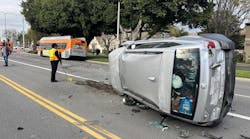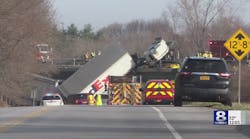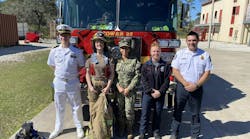SUBJECT: Vehicle Telematics Systems
TOPIC: OnStar – Part 1
OBJECTIVE: Responders will become familiar how the GM OnStar vehicle telematics communications system is designed and functions
TASK: Each member of the rescue team will be able to describe the crash information available regarding an OnStar-equipped General Motors vehicle and what patient information is available through the OnStar system
In the Intro to OnStar article, we were provided with an overview of this vehicle communications system owned by General Motors. In this article, we will take a closer look at how the telematics system works and what information can be provided to public safety responders.
Imagine that as you are responding to a vehicle crash call, you know all the important details of what happened before you even arrive. How nice would that be! You know if airbags deployed, whether it was a head-on, side-impact or rear-end crash. You know even before you are on scene if the vehicle rolled over, if occupants are still inside and if there are injuries. Better yet, you are being dispatched to the exact location where the vehicle is, not where some confused passer-by thinks the vehicle is.
In addition, imagine that your communications center personnel right now are speaking directly to the injured persons, and that they are gathering additional information as you are responding. All this is reality today if the vehicle involved in the crash is a GM vehicle with an OnStar telematics system installed and your communications center personnel are familiar with and trained to interact with OnStar Advisors during emergency calls such as this.
To make all this technology work involves satellite GPS vehicle location equipment, a roof-mounted vehicle antenna, wireless carrier connectivity and a two-way speaker/microphone. Although there is a primary wireless carrier used by OnStar as a default, OnStar’s robust system automatically will seek out other available wireless systems if needed to complete the emergency call.
On-site experience
This author had the opportunity to sit with the OnStar Emergency Advisors at the Warren, MI, call center to listen in as the “human connection” is made between the caller and the specially trained Advisor. Among the 2,500 Advisors that are working in the three call centers at any time, each location has Advisors who handle strictly the emergency OnStar calls. Besides being experienced OnStar Advisors, these specially selected and trained individuals undergo an additional 15-plus weeks of training as an Emergency Call Advisor before they begin answering emergency calls on their own.
It does not take long before one of the over 400 emergency calls that will be received that day comes in. With the flash of a red icon on the Emergency OnStar Advisor’s console, the emergency call is received and answered; one second of time has elapsed. The display screen tells the advisor whether it is an automatic crash call or a manual red button press. My first call to monitor was an automatic crash notification call so as the Advisor is still saying their opening line: “OnStar Emergency, are there any injuries?”, a companion portion of their computer console has automatically zoomed in and pinpointed the exact location of the vehicle, within three feet of accuracy in the U.S. and most of Canada.
The subscriber information has also displayed now along with the make, model, color and fuel type of the vehicle, if it is a General Motors vehicle. The OnStar Advisor can use Microsoft Virtual Earth technology—a 3D aerial imagery mapping and imagery system that can help accurately guide first responders to hard-to-find or remote locations. Just think how many times as a responder, you have had to search to locate the crash scene and the vehicles involved because your dispatch center had been given incorrect or inaccurate information based on passerby or Good Samaritan phone calls. With this telematics system, your dispatcher can direct you to where the vehicle is within a few feet. How nice is that!
We’re now about five seconds into the emergency call as the dialog between the OnStar Emergency Advisor and the vehicle occupant continues. By this time, yet another box on the Advisor’s console has filled in with collision data: direction of impact, change in velocity over time (known as Delta V), and if there’s a high probability of severe injury to the occupants. If the OnStar subscriber has the FMV aftermarket mirror unit installed, the Advisor knows that the collision has occurred, subscriber information displays, along with the exact location, and audio communication is through the internal wireless system with the two-way speaker/microphone in the vehicle.
Just as any call-taker at a communications center would be expected to do, the OnStar Advisor confirms the vehicle’s exact location and determines through questions to the vehicle occupants if there are injuries and if emergency services are needed. If there is an automatic crash notification and occupants are unconscious, the OnStar Advisor uses the automatically generated data and the proprietary database of PSAP boundaries to notify the local agency 911 center that has jurisdiction.
Now, about 20 seconds into the call, the EMS side of OnStar’s system can kick in. An additional Emergency Advisor, certified in Emergency Medical Dispatch (EMD) through National Academies of Emergency Dispatch (NAED), will join the call and speak directly with the OnStar customer to provide EMD medical assistance while the first Advisor contacts the 911 center with jurisdiction for the incident. Using the Medical Priority Dispatch System (MPDS) protocol, this second Advisor can provide pre-arrival medical assistance to the patient prior to the arrival of first responders. At the same time, the first Advisor is now clicking their mouse to place the emergency call directly to the appropriate 911 call center. OnStar’s computers draw from their database of over 6,500 PSAPs in North America, all within seconds. The Advisor provides the local 911 operator with the vehicle location and description, specific crash info and any information obtained by the second Advisor doing EMD.
At this point, approximately 60 seconds since the call was received, the second Advisor remains on the line continuing to provide medical care information to the injured occupants until first-arriving fire, medical, or law enforcement authorities confirm their arrival. At the discretion of the local PSAP, the vehicle occupant can be conference-called in to speak directly with the local dispatcher. The first OnStar Advisor, who answered the initial call, remains on the line as well in a supporting role and can call the 911 center back if circumstances change.
If a language barrier exists, OnStar’s in-house Spanish and French Advisors can be connected to provide help or the Language Line can be contacted to provide support in other languages. TTY services are also available 24/7.
In addition to location data that can be reported to your dispatch center, the OnStar Emergency Advisor may be able to verbally offer the 911 call taker the following critical data on severity and type of crash for most OnStar-equipped vehicles:
- Air Bag status (deployed?)
- Delta V (i.e., severity of impact?)
- Direction of impact?
- Whether there were multiple impacts?
- Whether vehicle may have rolled over?
- Injury Severity Prediction?
Medical responders will be interested in learning about the Injury Severity Predication information that OnStar has. When the OnStar Advisor provides your local 911 center with Injury Severity Prediction information, it is a result of the findings of a Center for Disease Control and Prevention (CDC) expert panel. The OnStar Advisor can advise the 9-1-1 call taker if there is a high probability of severe injury to vehicle occupants based on electronic crash data received from the GM vehicle itself. This data is automatically processed through a mathematical algorithm that has been well researched over several years and validated by this CDC panel, yielding OnStar’s prediction of injury and the severity of injury to occupants and their potential medical needs.
In Part 2, our final article on the OnStar telematics system, we’ll look at additional capabilities of OnStar and how Public Safety responders may take advantage of this technology to improve fire, rescue and medical operations involving OnStar-equipped vehicles.







